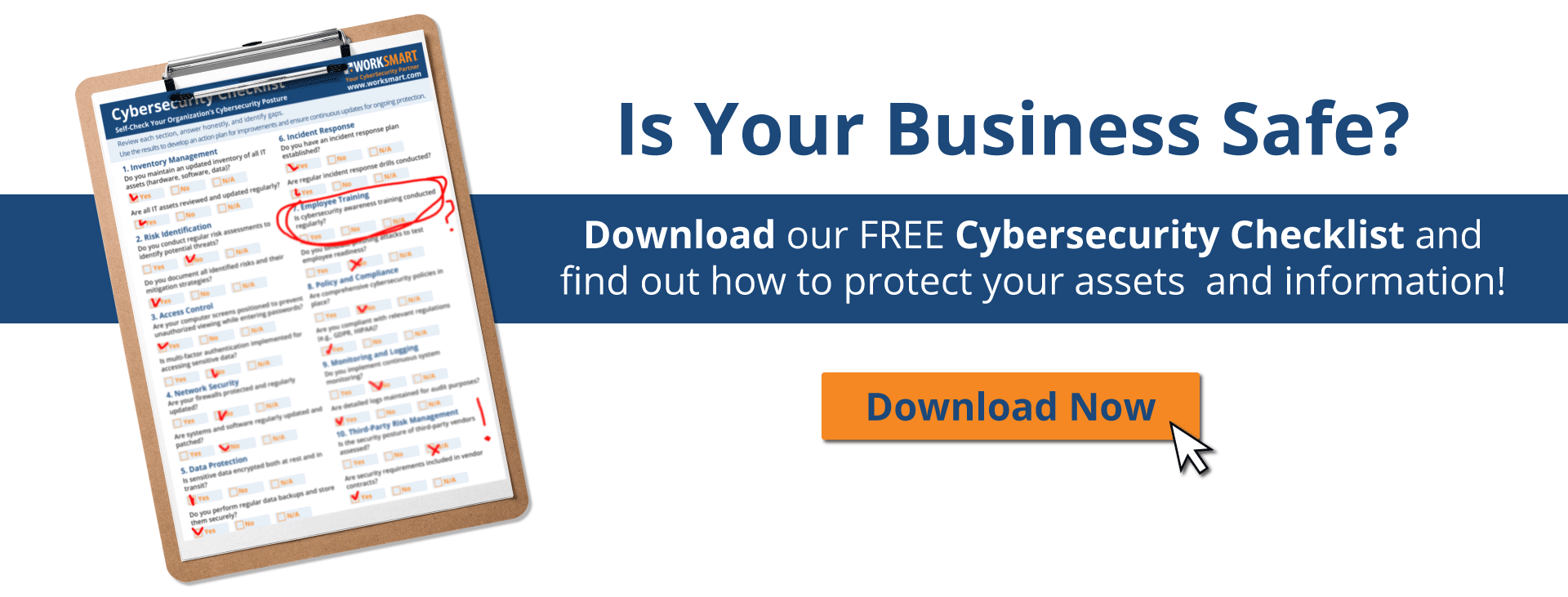So, how can you be sure your organization is doing the right things to prevent damage that can be caused by cyber threats and keep it within a small business budget?
Here are three steps that will help secure your business while controlling the cost.
What Can I Do to Protect My Business?
Begin with one change at a time as you work toward a strategic cybersecurity plan.
- Implement best practices in your workplace.
- Partner with an outsourced IT service provider for their technical expertise and ongoing, proactive IT support.
- Purchase cyber insurance to cover any losses and prevent permanent damage to your business.
Every single attack may not be prevented – but a well-thought-out cybersecurity structure will help to mitigate damages. Let’s dive into each of these areas so you can learn more about how to customize each approach to your business’s unique needs.
3 Steps to Securing Your Small Business on a Budget
Step 1: Build a Cybersecurity Strategy and Implement Best Practices
Here are 5 things you can do to build a security strategy that allows for proper budgeting:
- The NIST Cybersecurity Framework is a practical guide for identifying your assets, putting a basic protection plan in place, monitoring your systems on a continual basis, and having a recovery plan to bounce back quickly. You can use all of the best practices listed as an outline for your organization’s security strategy, helping you to decide where to focus resources.
- Make a big impact by implementing cost-effective security tools and simple processes designed to prevent cyber threats from getting access to your systems.
- Tip #1: Make sure software is up-to-date. Install security updates & patches on all of your organization’s systems.
- Tip #2: Improve password security. Follow suggestions for ensuring passwords are strong and kept private.
- Tip #3: Limit access to a “need to know” basis.
- Tip #4: Cover the basics of network security.
- Tip #5: Encrypt sensitive data.
- Tip #6: Implement a routine backup plan.
- Train your employees on basic cybersecurity practices. Set a company-wide policy to make sure everyone is doing their part to keep their data safe. Employee training helps mitigate risk and lower your cyber insurance premiums.
- Regular scanning and testing of networks and equipment help detect any vulnerabilities that could leave your business open to an attack. This risk-based approach to cybersecurity helps you continuously improve cyber defenses while optimizing your budget. Then, add 24×7 security monitoring to sniff out anything suspicious before it becomes an issue.
- Does your team know what to do if the business suffered an attack? Develop an Incident Response Plan as a bounce-back if something does occur. That way, you can minimize losses and downtime.
Step 2: Invest in Proactive IT Support Service from a Managed Service Provider
In addition to making a cybersecurity strategy a priority, it’s important to partner with an outsourced IT service provider for ongoing support.
Outsourced IT, also referred to as a Managed IT Service Provider (or just a Managed Service Provider), means a team of top-level experts working as an extension of your team at a fixed cost each month.
What does a Managed IT Service Provider do?
In short, they help your business use technology reliably and securely. With services that include 24/7 monitoring and ongoing support, an MSP focuses on keeping employees productive, software up-to-date, backups working (and ready if ever needed), and data secure.
MSPs have access to the best technology and stay current on the evolving threat landscape. They help point your business in the right direction by advising on how to keep your organization safe and by implementing security measures.
As your IT team, MSPs keep IT security top-of-mind whether they’re helping your office manager onboard a new employee, giving additional file permissions to a director, or resetting the CFO’s email password.
Cybersecurity is not a one-size-fits-all solution.
By assessing your ability to prevent, detect, and respond to cyber attacks, WorkSmart can help you build a cybersecurity strategy to manage and reduce your business’s risk.
Step 3: Invest in Cyber Insurance to Cover any Sudden Losses
Cybersecurity Liability Insurance (or just Cyber Insurance) might seem like an unnecessary expense, but when you consider the financial losses suffered after an attack, insurance is your best bet to recover faster and more efficiently.
- 43% of cyberattacks are on small and medium-sized businesses.
- 83% of small businesses are not financially prepared to recover from a cyberattack.
- A recent CISCO study discovered that the average downtime from a small business cyber attack was 8 hours.
- 61% of all small businesses have reported at least one cyber attack in the past year.
A cyber insurance policy helps your business remain operational after an attack. These policies commonly cover your business’s cost of lost profits, forensics, data restoration, and legal fees. The premiums can range from $500 to more than $50,000 a year with factors like security measures, coverage limits, and industry affecting the cost.
Good news! Working with a trusted insurance agent, you can build affordable and effective insurance tailored for your business.
By Following These 3 Steps, Your Business Stays Secure
In the hybrid world, cyberattacks aren’t going anywhere. To keep your business modernized and protected, you have to adapt and be prepared.
- Implement cybersecurity best practices as your first step and a basic level of protection. Be sure to execute company-wide policies and employee training so that everyone is aware and doing their part.
- Find an expert IT support service team to make sure all your bases are covered, 24/7.
- Invest in a cyber insurance policy to help recover from financial losses and downtime.
Every single attack may not be prevented, but a well-thought-out cybersecurity structure will help to mitigate damages. Remember, strengthening your understanding and defenses against cybersecurity threats will ultimately benefit your business!
Enhance Your Cybersecurity Strategy with Our New Services
To further support your efforts in fortifying your business against cyber threats, we are excited to announce the launch of our Cybersecurity Assessment Service. This service is designed to evaluate your current security posture and provide tailored recommendations to enhance your defenses. Learn more about our assessment service here.
Additionally, we are offering a FREE Cybersecurity Checklist to help you identify key areas of improvement in your security practices. This checklist provides actionable steps that you can implement immediately to strengthen your defenses. Download your free checklist here and take the first step toward a more secure business.



